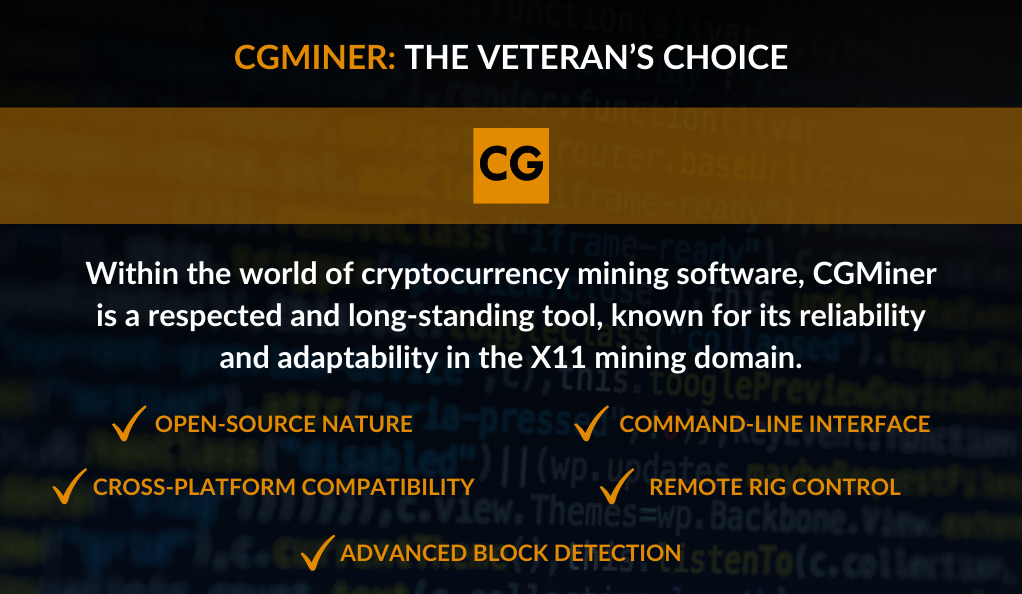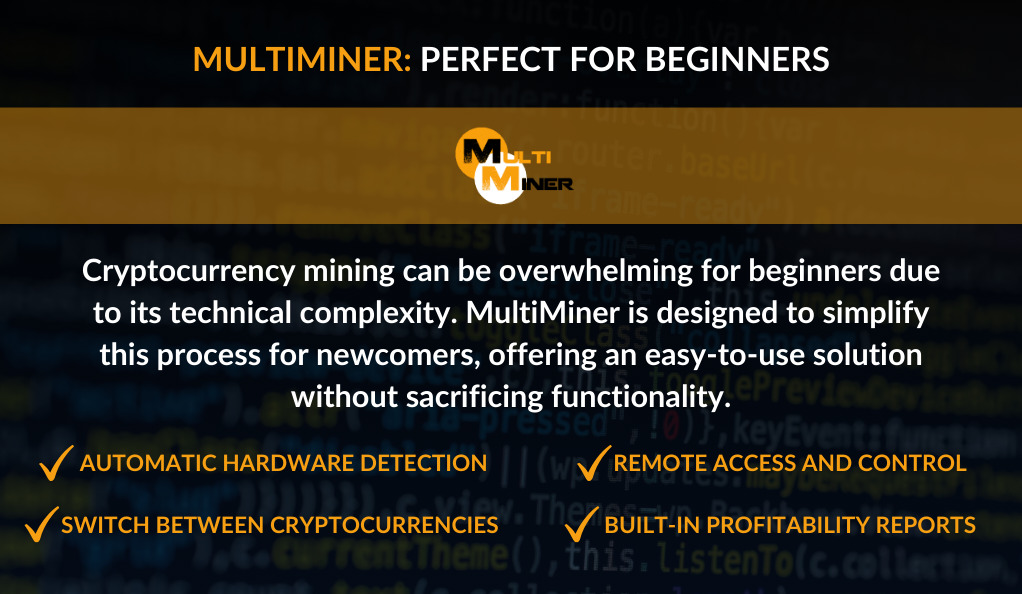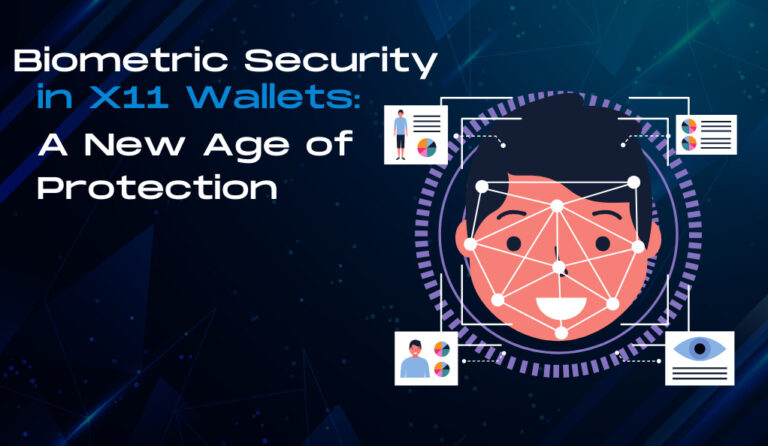In the intricate world of cryptocurrency, mining stands as a pivotal component, ensuring not only the creation of new coins but also facilitating transaction verification and enhancing the overall security of the network. X11, a widely recognized hashing algorithm, has garnered attention for its energy efficiency and compatibility with GPU mining. When it comes to X11 mining, the software you choose can significantly impact your profits and overall mining experience.
Understanding X11 Mining
X11, developed by Dash core developer Evan Duffield, is renowned for its ability to provide a cooler and quieter mining operation compared to other algorithms. It employs a chain of eleven scientific hashing algorithms, which not only provides a higher level of security but also makes the mining process more complex and resource-intensive. The X11 algorithm is utilized by several cryptocurrencies, with Dash being the most notable one.
Significance of Mining Software
Mining software acts as the bridge between the hardware and the mining pool or blockchain, facilitating the actual mining process. It controls the input from the miners, processes it, and sends it to the blockchain or mining pool. Moreover, it monitors the temperature, hash rate, fan speed, and overall performance of your mining rig, ensuring optimal functionality.
Choosing the Right Tool
Selecting the appropriate mining software is crucial as it directly influences your mining profitability and hardware longevity. Factors such as user interface, compatibility, and stability play a vital role in determining the efficacy of a mining program. This article aims to delve into a comprehensive comparison of popular X11 mining software, providing you with insights that will assist you in making an informed decision in your mining endeavors.
In the subsequent sections, we will explore various X11 mining programs, dissecting their features, usability, and performance to provide you with a detailed overview. From the veteran CGMiner and the highly customizable BFGMiner to the beginner-friendly MultiMiner and the centralized Awesome Miner, we will traverse through different software, ensuring you gain a thorough understanding of each, thereby aiding you in identifying the software that aligns perfectly with your mining objectives.
The Rise of Cryptocurrency Mining
The digital age has ushered in a plethora of innovations, and among the most groundbreaking is cryptocurrency. As decentralized digital assets, cryptocurrencies operate outside the purview of traditional banking systems, offering a new paradigm of value exchange. Central to the operation and sustenance of most cryptocurrencies is the process known as ‘mining’. But how did we arrive at this juncture, and what role does mining software play in this narrative?
A Brief History of Cryptocurrency Mining
The inception of cryptocurrency mining can be traced back to 2009 with the launch of Bitcoin, the pioneer of all cryptocurrencies. Bitcoin introduced the concept of using computational power to solve complex mathematical problems, a process that results in the addition of a new block to its blockchain. This ‘proof-of-work’ system not only facilitates the creation of new coins but also ensures the security and integrity of transactions.
Over the years, as the popularity of cryptocurrencies surged, so did the interest in mining. From hobbyists using their personal computers in the early days to massive mining farms with specialized hardware today, the evolution has been rapid and transformative.
Evolution of Mining Software
In the nascent stages of cryptocurrency mining, the software used was rudimentary, often crafted by enthusiasts and early adopters. As the potential profitability of mining became evident, the demand for more efficient and user-friendly software grew.
- 2009-2012: Mining was primarily done using CPUs (Central Processing Units). The software tools available were basic command-line programs, tailored for tech-savvy individuals.
- 2013-2015: The introduction of GPUs (Graphics Processing Units) into the mining arena marked a significant leap in mining efficiency. This period saw the emergence of software like CGMiner and BFGMiner, offering enhanced features and better compatibility with different hardware types.
- 2016-Present: ASIC (Application-Specific Integrated Circuit) miners, designed exclusively for cryptocurrency mining, became the gold standard. Mining software evolved to cater to these powerful machines, with tools like MultiMiner simplifying the process for beginners and Awesome Miner providing centralized management for large-scale operations.
The Significance of X11 in the Mining Landscape
While Bitcoin uses the SHA-256 algorithm, other cryptocurrencies sought more energy-efficient alternatives. Enter X11, a unique chaining of eleven hashing algorithms, offering both security and energy efficiency. The adoption of X11, especially by cryptocurrencies like Dash, prompted the development of specialized mining software optimized for this algorithm.
| Year | Significant Development | Impact on Mining Software |
|---|---|---|
| 2009-2012 | CPU-based Mining | Basic command-line tools |
| 2013-2015 | Advent of GPU Mining | Emergence of CGMiner & BFGMiner |
| 2016-Present | Rise of ASIC Miners | Introduction of MultiMiner & Awesome Miner |
CGMiner: The Veteran’s Choice

In the vast landscape of cryptocurrency mining software, CGMiner stands tall as one of the most seasoned and trusted tools in the industry. Its longevity is a testament to its robustness, adaptability, and the trust it has garnered among the mining community. Let’s delve into the intricacies of CGMiner, especially its relevance in the realm of X11 mining.
Overview of CGMiner
CGMiner, developed by Australian programmer Con Kolivas in 2011, is an open-source mining software that has withstood the test of time. Initially designed for Bitcoin and Litecoin mining, it has since evolved to support a multitude of algorithms, including X11. Its cross-platform nature ensures compatibility with various operating systems like Mac, Linux, and Windows.
Key Features of CGMiner
- Open-Source Nature: Being open-source, CGMiner’s code is accessible to everyone, allowing for transparency and community-driven improvements.
- Cross-Platform Compatibility: Whether you’re on a Mac, Linux, or Windows machine, CGMiner has you covered. This versatility extends to its support for various mining hardware, including ASICs, FPGAs, GPUs, and CPUs.
- Command-Line Interface: While it might seem daunting to beginners, the command-line interface offers direct controls, enabling seasoned miners to fine-tune their mining operations with precision.
- Remote Rig Control: Miners can control their rigs remotely, adjusting fan speeds, checking temperatures, and changing mining pools with simple keyboard commands.
- Advanced Block Detection: The software swiftly detects new blocks, ensuring that miners can transition seamlessly, maximizing their hashing power without delays.
Pros and Cons of CGMiner
Pros:
- Open-source, ensuring transparency.
- Supports a wide range of hardware.
- Allows remote rig control.
- Regular updates and active community support.
Cons:
- Might be challenging for beginners due to its command-line interface.
- Installation on Windows 10 can be tricky.
- Some antivirus software might flag it, requiring exceptions to be set.
Why CGMiner Stands Out
CGMiner’s longevity in the mining world is no accident. Its open-source nature ensures constant updates and improvements, driven by an active community of developers and users. The software’s adaptability to various hardware types, combined with its advanced features, makes it a favorite among seasoned miners.
However, its command-line interface might pose a challenge for novices. While it offers a plethora of advanced features for experts, beginners might find it slightly intimidating. But with a bit of patience and learning, even newcomers can harness the full potential of CGMiner.
BFGMiner: Customization at its Best
In the realm of cryptocurrency mining, while some tools prioritize user-friendliness, others focus on providing a plethora of features for the more tech-savvy miners. BFGMiner falls into the latter category, offering a suite of advanced functionalities that allow miners to tweak and optimize their mining operations to their exact specifications. Let’s dive deep into the world of BFGMiner and explore its offerings.
Introduction to BFGMiner
BFGMiner, a brainchild of developer Luke Dashjr, emerged in 2012 as a formidable contender in the mining software arena. Designed primarily for FPGA and ASIC mining, it quickly gained traction among miners who desired a higher degree of customization and control over their mining rigs.
Key Features of BFGMiner
- Dynamic Clocking: This feature allows miners to adjust the clock speed of their mining hardware, optimizing performance based on current conditions.
- Multiple Cryptocurrency Support: One of BFGMiner’s standout features is its ability to mine multiple cryptocurrencies simultaneously, providing flexibility and diversification for miners.
- Command-Line Interface: Like CGMiner, BFGMiner employs a command-line interface, granting users direct control over their operations.
- Remote Rig Management: Miners can oversee and control their rigs from a distance, making adjustments as needed without being physically present.
- Hardware Temperature Monitoring: Ensuring the longevity of mining hardware is crucial, and BFGMiner’s ability to monitor hardware temperatures helps in preventing overheating.
Pros and Cons of BFGMiner
Pros:
- Ability to mine multiple cryptocurrencies simultaneously.
- Extensive customization options.
- Active community support and regular updates.
Cons:
- Might be overwhelming for beginners due to its command-line interface.
- Limited to FPGA and ASIC hardware.
- The lack of a graphical user interface can be a barrier for some.
Why BFGMiner Shines in Customization
BFGMiner’s emphasis on customization is evident in its feature set. Whether it’s adjusting clock speeds, mining multiple coins, or monitoring hardware temperatures, the software provides miners with the tools they need to tailor their operations precisely. This degree of control can lead to optimized mining performance, potentially increasing profitability.
However, this power comes with a learning curve. The command-line interface, while offering direct controls, can be daunting for those new to the mining world. But for those willing to invest the time to learn, the rewards can be substantial.
MultiMiner: Perfect for Beginners

The world of cryptocurrency mining can be daunting for newcomers. With a plethora of technical jargon, complex configurations, and the need for constant monitoring, the barrier to entry can seem high. Enter MultiMiner, a software designed with the beginner in mind, aiming to simplify the mining process without compromising on functionality. Let’s explore what makes MultiMiner an ideal choice for those dipping their toes into the mining waters.
The User-Friendly Interface of MultiMiner
At the heart of MultiMiner’s appeal is its intuitive graphical user interface (GUI). Unlike many of its counterparts that rely on command-line interfaces, MultiMiner offers a clean, organized, and easy-to-navigate GUI. This design choice immediately lowers the intimidation factor, allowing even those with minimal technical knowledge to start their mining journey.
Key Features of MultiMiner
- Automatic Hardware Detection: Upon installation, MultiMiner automatically detects and lists available mining hardware, be it ASICs, GPUs, or CPUs. This feature eliminates the need for manual configurations, streamlining the setup process.
- Switch Between Cryptocurrencies: MultiMiner allows users to switch between different cryptocurrencies with ease. Whether you’re mining Bitcoin, Litecoin, or any other coin, transitioning is just a click away.
- Remote Access and Control: Even though it’s beginner-friendly, MultiMiner doesn’t skimp on advanced features. Users can remotely monitor and control their mining rigs using the MultiMiner Mobile app or any web browser.
- Built-in Profitability Reports: For those keen on tracking their mining profitability, MultiMiner provides real-time reports, offering insights into potential earnings.
Pros and Cons of MultiMiner
Pros:
- Intuitive graphical user interface.
- Supports multiple cryptocurrencies.
- Regular updates and active community support.
- Built-in profitability reports.
Cons:
- Might lack some advanced features desired by expert miners.
- Higher CPU usage compared to some other mining software.
- Primarily designed for Windows, though it can run on Mac and Linux using Mono.
Why Beginners Might Prefer MultiMiner
The world of cryptocurrency mining is vast and can be complex. For those just starting out, the learning curve can be steep. MultiMiner addresses this challenge by offering a platform that’s both powerful and accessible. The GUI simplifies tasks that might otherwise require intricate command-line inputs, and the software’s ability to automatically detect hardware and switch between cryptocurrencies further eases the process.
While seasoned miners might opt for software that offers a deeper level of customization, MultiMiner’s balance of simplicity and functionality makes it a compelling choice for newcomers.
Awesome Miner: Centralized Management for Professionals
In the vast spectrum of cryptocurrency mining, there exists a segment of miners who operate on a larger scale, managing multiple rigs across different locations. For such professionals, the need for centralized management becomes paramount. Awesome Miner, as its name suggests, aims to be the go-to solution for these miners, offering a suite of tools designed to streamline, optimize, and centralize large-scale mining operations.
Overview of Awesome Miner
Awesome Miner, developed by IntelliBreeze Software AB, is a Windows-based application designed to manage and monitor mining operations. While it caters to individual miners, its true prowess shines when deployed for large-scale operations, offering a centralized dashboard from which miners can oversee all their rigs.
Key Features of Awesome Miner
- Centralized Dashboard: At the core of Awesome Miner is its centralized dashboard, which provides a holistic view of all mining activities. From here, miners can monitor hash rates, temperatures, profitability, and more, across all their rigs.
- Multi-Algorithm Support: Awesome Miner supports over 50 mining algorithms, including X11. This versatility ensures that miners can switch between different coins based on market conditions and profitability.
- Profitability Switching: One of the standout features of Awesome Miner is its ability to automatically switch between coins based on real-time profitability data, ensuring that miners always mine the most profitable coin.
- Notifications and Recovery: Miners receive notifications for any issues, such as machines going offline or overheating. The software can also automatically restart miners or execute custom scripts to resolve common issues.
- Cloud Services: For those who wish to monitor their operations remotely, Awesome Miner offers cloud services, allowing miners to access their dashboard from any device, anywhere.
Pros and Cons of Awesome Miner
Pros:
- Comprehensive centralized management.
- Supports a wide range of mining algorithms.
- Advanced automation and recovery features.
- Regular updates and a responsive support team.
Cons:
- The full suite of features might be overkill for individual miners.
- Primarily Windows-based, limiting OS diversity.
- The premium version, which unlocks all features, comes at a cost.
Why Awesome Miner is Ideal for Large-Scale Mining
The challenges faced by large-scale miners differ significantly from those of individual miners. The complexity of managing multiple rigs, often spread across different locations, requires a tool that can centralize, automate, and streamline operations. Awesome Miner rises to this challenge, offering a comprehensive solution that reduces the manual oversight required, ensures optimal profitability, and provides timely alerts and recovery options.
For individual miners or those operating on a smaller scale, the extensive feature set might seem overwhelming. However, for mining farms or professionals managing multiple rigs, Awesome Miner’s centralized approach can be a game-changer, offering a level of oversight and automation that can significantly enhance efficiency and profitability.
Factors to Consider When Choosing X11 Mining Software

The world of X11 mining software is vast, with each program offering a unique blend of features, functionalities, and user experiences. While the previous sections delved into specific software, it’s essential to step back and view the broader picture. How does one decide which software is the best fit for their needs? In this section, we’ll explore the critical factors to consider when selecting X11 mining software, ensuring you make an informed and beneficial choice.
Ease of Use vs. Advanced Features
For many, especially those new to mining, a user-friendly interface can be a deciding factor. Software like MultiMiner, with its intuitive GUI, caters to this demographic. However, seasoned miners might prioritize advanced features and customization options, even if it comes with a steeper learning curve, as seen with BFGMiner.
Compatibility with Different Operating Systems and Hardware
Your choice of mining software should align with your hardware and operating system. While some software is cross-platform, like CGMiner, others might be limited to specific operating systems, like Awesome Miner’s primary focus on Windows.
Community Support and Software Updates
Mining is a dynamic field, with constant developments and changes. Software that receives regular updates and has an active community can adapt to these changes, ensuring longevity and continued relevance. Regular updates can address bugs, introduce new features, and optimize performance.
Cost Implications
While many mining software options are free, some might come with a price tag, especially for premium features. It’s essential to weigh the benefits of these features against their cost, ensuring you get value for your money.
Security and Stability
In the world of cryptocurrency, security is paramount. Ensure that the software you choose has robust security features, protecting against potential threats. Additionally, stability is crucial. Software that crashes frequently can lead to lost mining time and potential revenue.
Profitability Features
Some software, like Awesome Miner, offers profitability switching, ensuring you always mine the most profitable coin. While not a necessity, such features can enhance earnings, making them a valuable consideration.
Customization and Scalability
Your mining operations might grow over time. Software that offers scalability, allowing you to manage multiple rigs from a centralized dashboard, can be beneficial in the long run.
The Future of X11 Mining Software
As we stand on the cusp of a new era in technology and digital finance, the future of cryptocurrency and, by extension, mining software, remains a topic of fervent discussion. The X11 algorithm, with its unique blend of eleven hashing functions, has carved a niche for itself in the crypto landscape. But what does the future hold for X11 mining software? Let’s embark on a speculative journey, exploring potential trends, innovations, and challenges that might shape the next chapter of X11 mining.
Adaptation to New Hardware Technologies
The relentless pace of technological advancement ensures that today’s cutting-edge hardware might become obsolete tomorrow. Future X11 mining software will need to adapt to newer, more efficient hardware, ensuring compatibility and optimization.
Increased Emphasis on Energy Efficiency
As global awareness about environmental sustainability grows, the energy consumption of mining operations comes under scrutiny. Future iterations of X11 mining software might prioritize energy efficiency even more, optimizing operations to reduce the carbon footprint.
Integration with Decentralized Finance (DeFi) Platforms
DeFi platforms are revolutionizing the world of finance, offering decentralized alternatives to traditional financial systems. X11 mining software might integrate more closely with these platforms, allowing miners to directly participate in DeFi activities, enhancing profitability and utility.
Enhanced Security Protocols
With the increasing value and prominence of cryptocurrencies, security threats also rise. Future mining software will likely incorporate advanced security protocols, safeguarding miners against potential threats and ensuring the integrity of mining operations.
User Experience and Accessibility
As cryptocurrency mining attracts a broader audience, the demand for user-friendly and accessible software will grow. We might witness a trend where X11 mining software becomes more intuitive, catering to both novices and experts alike.
Collaborative Mining and Community-driven Development
The ethos of cryptocurrency revolves around decentralization and community participation. This philosophy might permeate the development of X11 mining software, with more community-driven features, collaborative mining options, and open-source development.
Predictive Analytics and AI Integration
The integration of Artificial Intelligence (AI) and predictive analytics can revolutionize mining. By analyzing market trends, hardware performance, and other variables, future software might offer predictive insights, guiding miners on optimal strategies and configurations.
Conclusion: Making the Right Choice in X11 Mining Software
Navigating the vast landscape of X11 mining software requires a keen understanding of one’s specific needs, whether you’re a beginner seeking an intuitive interface or a seasoned miner desiring advanced customization. Balancing performance with usability is crucial, and while profitability is paramount, the value of an active community and robust support cannot be overstated. As the world of cryptocurrency continues its dynamic evolution, staying updated, adaptable, and engaged with the mining community will be key to harnessing the full potential of X11 mining.
In the ever-changing realm of cryptocurrency, the software you choose can significantly influence your mining journey. By prioritizing personal needs, leveraging community insights, and being future-ready, miners can position themselves for success. As we look ahead, the promise of advancements in AI, energy efficiency, and integration with broader digital finance platforms suggests an exciting future for X11 mining enthusiasts.
At axerunners.com, our goal is to furnish well-rounded and trustworthy information regarding cryptocurrency, finance, trading, and stocks. Nonetheless, we avoid providing financial advice and instead encourage users to conduct their own research and meticulous verification.
Read More













